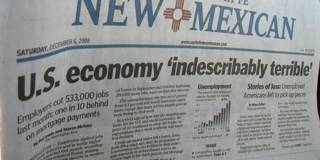Though the Federal Reserve is turning a blind eye to the spillover effects of its monetary policy, the impact on emerging economies has been profound. Will the foreign reserves that these countries have built up in recent years prove adequate to protect their financial systems, as liquidity flows back toward developed economies?
NEW DELHI – Though the US Federal Reserve is turning a blind eye to the spillover effects of its monetary policy, the rest of the world is worrying about the impact that capital-flow reversals will have on emerging economies. Will the foreign reserves that these countries have built up in recent years prove adequate to protect their financial systems, as liquidity flows back toward developed economies?
The short answer is no, because excessive self-insurance ultimately does more harm than good. In order to break the destabilizing cycle of short-term capital flows and excessive accumulation of foreign reserves, the International Monetary Fund, with broad support from the G-20, must devise new rules regarding monetary-policy spillovers.
Severe crises leave an imprint on a nation’s psyche. In the late 1990’s, the currency and banking crises that ravaged Asian economies led the affected countries’ leaders to a simple conclusion: no amount of insurance was too much. Although the introduction of floating exchange rates removed the incentive to borrow in a foreign currency (and thus the need for self-insurance), the political humiliation of losing sovereignty to the IMF – if only temporarily – was so devastating that the economic costs of building a massive foreign-currency war chest seemed worthwhile. But these countries’ leaders failed to grasp the full consequences.

NEW DELHI – Though the US Federal Reserve is turning a blind eye to the spillover effects of its monetary policy, the rest of the world is worrying about the impact that capital-flow reversals will have on emerging economies. Will the foreign reserves that these countries have built up in recent years prove adequate to protect their financial systems, as liquidity flows back toward developed economies?
The short answer is no, because excessive self-insurance ultimately does more harm than good. In order to break the destabilizing cycle of short-term capital flows and excessive accumulation of foreign reserves, the International Monetary Fund, with broad support from the G-20, must devise new rules regarding monetary-policy spillovers.
Severe crises leave an imprint on a nation’s psyche. In the late 1990’s, the currency and banking crises that ravaged Asian economies led the affected countries’ leaders to a simple conclusion: no amount of insurance was too much. Although the introduction of floating exchange rates removed the incentive to borrow in a foreign currency (and thus the need for self-insurance), the political humiliation of losing sovereignty to the IMF – if only temporarily – was so devastating that the economic costs of building a massive foreign-currency war chest seemed worthwhile. But these countries’ leaders failed to grasp the full consequences.